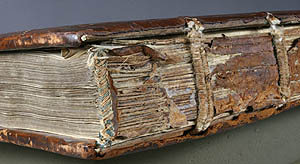For about a year, I was looking forward to attending this symposium, which was organised by the Department of Scientific Research at the British Museum, with support from The Andrew W. Mellon Foundation. This was an unprecedented effort to gather conservators, conservation scientists and curators to present and discuss one of the most fascinating aspects of our work: the understanding of materials and techniques used by artists. It brought an opportunity to discuss conservation-related issues and the curatorial implications raised by scientific studies. The results from the work presented at the conference can most definitely be applied in the library context, and thus I found this conference most relevant when one considers current and future collaborations between different departments in The Bodleian Libraries, Oxford University and beyond.
The main subject of discussion were the extensive scientific studies of drawings from the British Museum and the Gabinetto dei Disegni e delle Stampe at the Uffizi, Florence, carried out in preparation for the exhibition Fra Angelico to Leonardo: Italian Renaissance drawings (22 April – 25 July 2010).
Most of the talks were tailored around a methodology of work often used collaboratively by curators, conservators and scientists to develop a conservation approach: 1. Historical understanding of the provenance of items or collections, 2. Visual examination and technical imaging, 3. Chemical analysis, and 4. Conservation treatment.
A wide range of fascinating and well presented papers on the examination and characterisation of master drawings’ materials helped the audience to learn about the latest imaging techniques, such as the recently developed near infra-red multi-band scanner (“NIR”), which is currently being used for the study of Caravaggio’s paintings at the Opificio delle Pietre Dure e Laboratorio di Restauro Firenze. With regard to new imaging techniques, I particularly enjoyed Margaret Holben-Ellis talk “Reflecting Raphael: a closer look at the Morgan’s Agony in the Garden”, an enthralling presentation of the characterisation of the media used to depict the underdrawing in this cartoon. Visualising the morphology of the pricking in Raphael’s cartoon with the HIROX 3-D microscope was a compelling new experience for most of the audience. We were unanimously mesmerised by the wealth of information obtained with this imaging technique, which will contribute to a more comprehensive art historical understanding of Rafael’s cartoons.
I was intrigued by Lara Broeke’s current work on the translation into modern English of Cennino Cennini’s “Libro dell’Arte”, the 15th century “how to” book on Renaissance Art, which, amongst many others, includes techniques and recipes for underdrawing and miniatures for the illumination of manuscripts. Lara’s work is an update after Daniel V. Thompson’s translation, and includes the acknowledgements of ambiguities in Ceninni’s text, alongside with some corrections to Thompson’s translation. These corrections are based on empirical evidence after systematic reconstructions of the recipes, such as the preparation of ultramarine pigment and bistre ink, which are both used in the illumination of manuscripts as well as in master drawings. After this talk, I enjoyed the discussions on the use of bistre and iron gall ink by artists. Bistre was a common ink in the Renaissance, but with poorer flow properties than iron gall ink (used in Europe since the 12th century). Additionally, bistre is more transparent than iron gall, making it a better option to apply washes, rather than to produce lines fluently. Non-destructive instrumental analysis carried out on a large number of drawings suggests artists constantly used both inks in combination to achieve diverse effects in their drawings.
Well known, non-contact and non-invasive (non-destructive) analytical techniques were also highlighted by several talks during the day. I was impressed with the combined use of micro-Raman spectroscopy, micro-FTIR, XRF and vis-RF to study Andrea Mantegna paintings. This study involved the characterisation of iron gall ink and other materials used in works long attributed to this artist (“Madonna della Tenerezza” and “The Virgin Mary with a Child”), confirming that areas of the backgrounds were not painted by him.
Overall, this was an extremely useful and well attended symposium, which significantly contributed to acknowledge the need to continue pioneering the study of artists’ (and makers’) techniques in the museums, libraries and archives context.
Virginia M. Lladó-Buisán, Head of Book & Paper Conservation, Bodleian Libraries









